What is HRMS full form?
HRMS full form is Human Resources Management System. Any organization, no matter how small or big needs a team dedicated to taking care of every worker. The team which is responsible for employee management is called HRM. With the help of HRMS software, the team is dedicated to finding and managing the best human resource for their company.
With every advanced and new technology coming into the world, there is a need for an advanced human resource system as well. Handling everything manually has become mundane and tiring for the HR department.
Thus, many organizations have introduced a system to lessen the burden on HR, which is the HRMS. The new-age human resources management system is built with innovative features like employee information management, recruitment and hiring, talent management and acquisition, Financial management, Time and absent management, and Learning and professional management that can ease the burden of HR and streamline the entire HR practices. HRMS software solution is also available in a mobile app.
In this blog, we are going to share the HRMS full form and definition of a human resource management system, its features, benefits, significance, and more.
What is HRMS or Human Resource Management system?
Human Resource Management System or HRMS is a suite and software application that manages the entire HR practice and HR solution. It streamlines the complete HR practices and HR functions that include employee data management, payroll management, recruitment, benefits, training, onboarding, performance tracking, employee engagement, and absent management. One HR software manages the whole administrative workforce.
Besides HRMS, The Human resource software solution is also known as the human resource information system. It has been used to post trending news or information, about the nation of the employees of the workforce. Previously the human resource management system was based on the database, but recently, it has become today’s human capital management cloud solution.
Also Read: Human Resource Management (HRM) Definition & Meaning
Features of Popular Human Resource Management Software (HRMS)
One proper human resource management system covers the entire workforce management. It includes streamlined recruitment and hiring, employee performance management and tracking, finance and payroll management, etc.
Let’s dive into the features of human resource management software (HRMS).
➔ Employee information management
Human resource management software has one most essential features of an employee information management system. It refers to the collection and maintenance of employee personal data, job history, salary, leave request, tax and loan information, leave request, and other relevant data, etc.
➔ Talent management and acquisition
Human Resource Management (HRMS) ensures the quick talent management and acquisition process. With the proper HRMS inclusion employers can identify the long-term talent requirement for the relevant vacancy. It ensures quick and quality hiring and streamlined onboarding thus leading to employee engagement, employee satisfaction, and increased productivity.
Talent management and acquisition software make a close collaboration of HR department specialists and talent acquisition specialists, with input from senior executives.
➔ Payroll Management
Payroll System is a cloud-based feature of the HRMS that integrates, manages, and automates the entire payroll process in the workplace.
With the upgraded payroll process, HR can easily handle compliances, calculate payroll, and loans, analyze the tax and policies, and disburse the employee payroll graph.
HRMS with the right payroll features, employers can tally the employee’s incentives percentage by analyzing the performance. And generating auto payslip help to maintain the security of the employee database as well.
➔ Financial management
Handling the database manually and maintaining dozen of employees’ finance at once is a time-consuming and error-prone task. Using a cloud-based financial management system HR can enhance the complete budgeting, keep track of expenses, better budgeting, and relocate resources.
With a proper financial management system HR or other financial experts can easily sort out the different modules on base salary administration, commissions, bonus programs, and stock and long-term incentive management.
Even if some MSMEs can use the financial management system to navigate the financial landscape. for the
➔ Time and absent management
Time and attendance management systems in HRMS, play a vital role in the HR practices and solution. With the software, employers can track the accurate attendance of employees including their login and log-out time, break and leaves, etc.
The system provides real-time reporting and analytics capabilities. HR managers can access attendance data, generate reports, and analyze attendance trends to gain insights into employee productivity, identify attendance-related issues, and make data-driven decisions.
Along with tracking employees’ presence, the innovative solution HR can create provides workforce planning, maintains payroll accuracy and updates compliance like labour laws, employment contracts, and industry-specific regulations regarding working hours, overtime, and leave policies.
The attendance management system can automatically calculate and enforce rules related to attendance, ensuring fair and consistent application of policies.
➔ Learning and professional management
Employees of any organization always need to improvise themselves. HRMS ensures a learning and professional management system that helps employees acquire knowledge or develop skills through relevant courses, certifications, and other curriculum development.
Proper training and knowledge development courses lead to employee satisfaction, employee engagement, and retention.
What is the use of the HRMS?
- Employee experience
- Data availability
- Unified platform
- Informative reports
- Automated processes
- Tracking capability
What are the benefits of HRMS?
In recent company culture, integrating HRMS is essential. It streamlines the automation process of data analytics. The software system facilitates compliance risk and provides rich data sets and strategies for complex decision-making processes which make HR professionals more productive.
Let’s discuss the top five business benefits of an HRMS.
➔ Easy Onboarding
It is said that a first impression is the last impression, and rightly so. When new hires join an organization, they have expectations and aspirations for a particular job. Through an onboarding process, a candidate comes to know all about an organization that is, targets, goals, work schedule, culture, etc. A good HRMS can help in making this conducive by making the interaction of a candidate with an organization lasting and positive.
The system will help the new hires in realizing their targets and responsibilities towards the organization and thus help in aligning their future with it. An onboarding process is equally easy for HR as every important document required can be uploaded by a candidate directly. They can directly upload through that portal, making it seamless for HR too.
➔ Efficient HR operation
HR practices is a confusing and complex work. Often they face challenges during data handling, employee performance tracking, and data analytics. Though are many separate tools, it is difficult for HR to handle them together.
HRMS is a one-time solution for entire HR practices and solutions. It streamlines administrative work that leads to smooth and quick output.
Automating administrative tasks and providing comprehensive HR functionalities, allows HR professionals to focus on strategic initiatives, talent management, and employee development, ultimately contributing to an efficient and effective HR operation.
Additionally, all Organizations are enjoying the efficiency of cloud-based HRMS recently.
➔ Detailed analysis
Many times, employers get confused at the time tracking and analyzing employee performance, attendance, and payroll in detail.
HRMS software ensures quick and relevant candidate research, smooth onboarding, the right scheduling of employee training, employee performance tracking, attendance tracking, and more.
Moreover, with HRMS HRs and finance specialists can work on the same platform easily, cause it also provides a clarified payroll solutions. So that employees not only get their salary on time but also enjoy their incentives and benefits on time.
HRMS and detailed analysis help in employee engagement, and increase the employee retention rate.
➔ Routine task automation
It is another essential issue, handling, maintaining, and scheduling tasks for employees faced by HR. HRMS provides auto-routine HR tasks so that organizations can save time, reduce errors, improve data accuracy, and streamline processes. HR professionals can focus on strategic initiatives, talent management, and employee engagement, ultimately contributing to increased productivity and organizational efficiency.
➔ Excellent Data Security
Earlier Organizations often messed up with secure databases. they have to take care of the bundle of files for years. There was a risk of error or data breach or data theft. By implementing HRMS software these security measures, organizations can enhance data protection, mitigate risks, and maintain excellent data security within their HRMS.
It is crucial to regularly review and update security practices to stay ahead of evolving threats and protect sensitive employee information effectively
➔ Enhanced Data Transparency
This is one of the key benefits of installing HRMS. It ensures that every worker in an organization has a crystal clear view of their policy, as well as other organization policies. HR can easily add all the employee-related information through the dashboard, like their leave balance, holiday calendar, performance graphs, etc.
➔ Common Platform
Modern HRMS provides a common platform for every worker in an organization to share personal thoughts and ideas. By creating surveys and group activities, employee engagement can be enhanced to a great level. HR also organizes online training for new hires or a particular team of an organization if needed. Such activities boost every worker’s morale and engagement.
All a worker needs to know is login onto the portal, and all the data is a click away. This helps the workers in becoming aware of their benefits policies, provident schemes, etc. Correspondingly, it benefits human resources as well, as they too can view every employee-related data such as their work schedules, skill sets, leave applications, etc.
Also here: Evolution of HRM(Human Resource Management)
There are many advantages of integrating HRMS in all companies. The government has now also introduced e-HRMS to simplify things further. An e-HRMS full form is the Electronic Human Resource Management System.
It refers to an intersection between Human Resource & Information Technology departments in any organization, where every government worker can easily view and edit their data, apply for leaves, and perform various tasks seamlessly without any help from HR.









